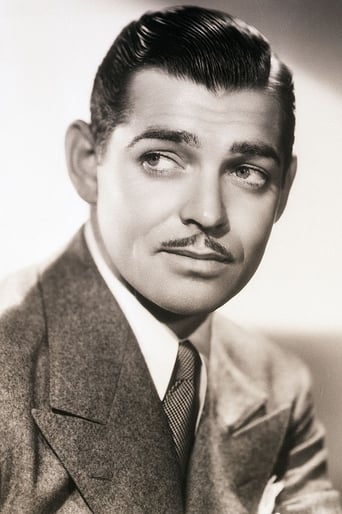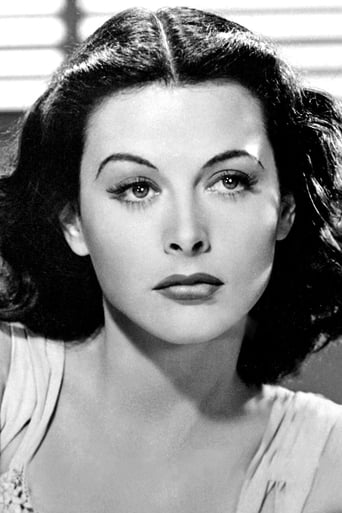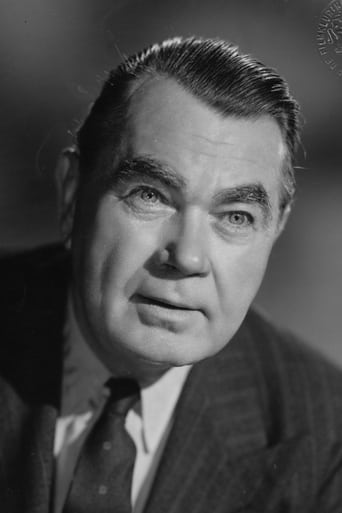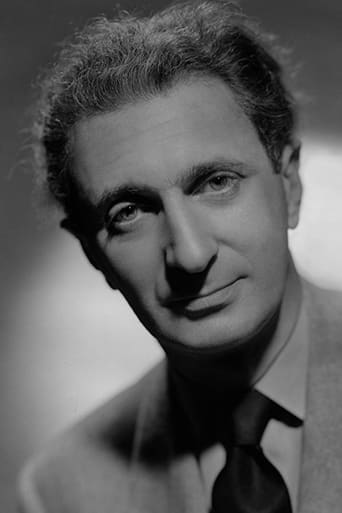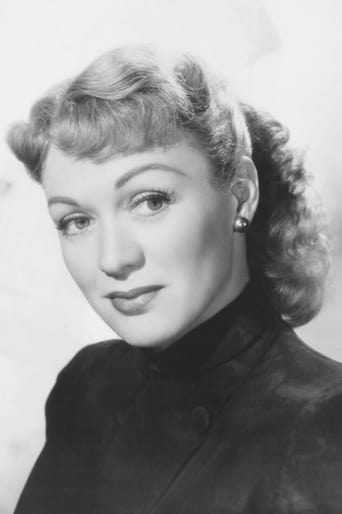BlazeLime
Strong and Moving!
Phonearl
Good start, but then it gets ruined
Hadrina
The movie's neither hopeful in contrived ways, nor hopeless in different contrived ways. Somehow it manages to be wonderful
Asad Almond
A clunky actioner with a handful of cool moments.
rickrudge
Comrade X (1940)Just before we got into World War II, Nazi Germany and the Soviet Union had signed a non- aggression pact. Mac Thompson (Clark Gable) is a foreign correspondent who has been sneaking out uncensored news out of Soviet Russia. The secret police are suspicious of him, but it's the hotel's valet, Igor Yahupitz (Felix Bressart) who knows that it's Mac. He tells Mac that if he can smuggle his daughter, Theodore (Hedy Lamarr) out of the Soviet Union, into America, he won't tell anybody.The fly in the ointment is that Theodore is a loyal Communist and, just like in Ninotchka (1939), Mac has got to convince her to leave her beloved country and go with him, all while trying to stay away from the Commissars. Of course all of the upper ranking Soviet officers are worried about being killed off in Stalin's Purge.King Vidor directed this fast-paced anti-communist comedy with a screenplay written by Ben Hecht. Jane Wilson (smart-mouthed Eve Arden) is one of my favorite characters, also the Nazi correspondent Emil Von Hofer (Sig Ruman) is an easy target of ridicule.
jacobs-greenwood
Walter Reisch, who contributed to the screenplay (and shared an Academy Award nomination in that category) for Ninotchka (1939), earned a Best Writing, Original Story Oscar nomination for this similar comedy drama starring Clark Gable and Hedy Lamarr (in lieu of Greta Garbo and Melvyn Douglas). Ben Hecht and Charles Lederer wrote the screenplay for this one, which was directed and co- produced by King Vidor.Gable plays an American journalist, McKinley 'Mac' Thompson, in communist Russia who successfully, and secretly, gets his stories and photographs through the government censors. He's referred to as Comrade X, and obviously the Russians would like nothing more than to capture and execute him for these traitorous activities. Lamarr plays Golubka, aka Theodore Yahupitz, a 'cold' native and party idealist who's not only a streetcar conductor, but also the daughter of Mac's friendly, though seemingly clueless valet Vanya, aka Igor Yahupitz (Felix Bressart).Vanya discovers Mac's secret camera and true identity and, because he wants to protect his daughter from the instability inherent in the system during that time, he 'forces' him to agree to take Golubka out of the country for her own safety. Bressart and Sig Ruman, who plays a German journalist Emil Von Hofer, were both in Ninotchka (1939). Oskar Homolka plays Commissar Vasiliev, who's desperately trying to catch Comrade X while at the same time keep from being assassinated by others seeking a power grab. Eve Arden plays Jane Wilson, another American journalist, who'd had prior relations with Mac. Vladimir Sokoloff plays Michael Bastakoff, the underground communist leader that Golubka idolizes. Keye Luke appears uncredited as another journalist in the frustrated World Press corps.The comedy is not nearly as good as the aforementioned film and is much more screwball, in general, with fewer of its political jabs finding their target. Though both Gable and Lamarr are both as watchable as usual, there's no real chemistry between them even as he tries to 'crack' her cold committed demeanor.Natasha Lytess plays a silly Russian secretary, Olga Milanava, who gets drunk. Mac pretends to be a communist in order to convince Golubka to leave for the United States with him (e.g. to persuade Americans to join the party); the two even get married!The movie gets even more off track when Mac, Vanya and Golubka, escaping from Bastakoff who has now successfully replaced (executed) Commissar Vasiliev, find themselves in an elaborate, overlong and climactic, tank chase!
theowinthrop
Ernst Lubtisch's classic comic statement about Communist Russia, NINOTCHKA, came out in 1939. Whether it "influenced" the production (also by MGM) of COMRADE X or not I could not say. Certainly there are similarities between the comedies. Lubitsch set his comedy in Paris, where a Communist trade mission is living it up, being corrupted by an émigré Russian noble (Melvin Douglas) so he can try to retrieve jewelry that the trade mission is using as collateral. The Russian government does not trust the three men sent, so they send a fiercer ideologue (Greta Garbo in the title role) who starts straightening out the mission, until she falls for Douglas's charm. In the end she is lured back (with her three associates) to the west and away from the Soviet paradise.NINOTCHKA had Felix Bressart and Sig Ruman in the cast as two of the members of the trade mission. Comments on this thread point out that in the 1930s "accents" were fairly interchangeable in Hollywood, so that the Swedish Garbo (and later the Austrian Lamarr) became Russian. So did German Ruman and German - Jewish Bressart (who would also play a Hungarian in THE SHOP AROUND THE CORNER).Unlike NINOTCHKA, COMRADE X is set inside that nightmare land, Stalinist Russia. Somebody is sending out unofficial (but thoroughly correct) news stories showing the crimes being committed in Russian by the government against the people (i.e. the purges), as well as the idiotic projects and waste mismanagement illustrative of how poorly the government is as effective government. This is being resented by the Presidium, who is represented by Oscar Homlolka (Commissar Vasiliev). Please note that Homolka's make-up makes him look a tremendous bit like one Joseph Stalin. At a public funeral covered by the press court, someone tries to shoot Vasiliev (who does all he can to hide the assassination plot). Mac Thompson (Clark Gable), the American reporter, manages to snap a photo of an odd site - a bearded man who a moment before the shooting opened up the lid of the coffin and popped out. This bearded gentlemen turns out to be one Michael Bastakoff (Vladimir Sokoloff), a rival of Vasiliev for power. He is made to look a tremendous bit like one Leon Trotsky.Get the message from Hollywood here? Vasiliev's agents have been trying to pin down the news leaks, and has narrowed it to two figures: Thompson, and one Emil Von Hofer (Sig Ruman) who is the news representative from Nazi Germany. Ruman manages to demonstrate it ain't him, so (despite Gable's breezy denials) Vasiliev believes it is the American.Gable has a close friend in Moscow, one Ygor Yahupitz (Felix Bressart) who is his sometimes valet. Ygor's daughter is Galubcha (Hedy Lamarr) who is a streetcar operator. Ygor wants Gable to try to smuggle Galubcha out of the Soviet Union into the U.S. And the film shows (among other things, including overcoming Galubcha's fierce belief in the Communist ideal) Gable eventually saving both the girl and her father.The comedy is quite amusing, even if it lacks the style and grace of the Lubitsch touch of the first film. But it certainly comments on the atmosphere within Russia in a way that NINOTCHKA failed to do so. The centering of the comedy in Moscow, the suggestiveness of a Stalin - Trotsky rivalry clone, and the heavy control over information is certainly more realistic than Douglas' being elegant and eloquent about the beauties of Paris.One more thing to keep in mind is a scandal which is on target with this film, and which (in 1940) finally began to raise eyebrows. In the early 1930s the New York Times had a reporter named Walter Duranty in Moscow. He turned out to be a fantastically well informed reporter in the Soviet Union, and came out with interviews and articles that were tremendously informative. In fact, he would win the Pulitzer Prize for his reporting from Moscow. But as time passed, Duranty's methods and sources were heavily questioned. He also tended to take an official line about the Purge Trials (i.e., that Bukhanin, Radek, Zinoviev, Tuchochevsky, and the other hundreds and thousands of victims were all actual traitors against the Stalinist regime). After the signing of the non-aggression pact with Germany in 1939, the Times became very suspicious of Duranty, and replaced him. The quality of the articles became very much more even handed. Duranty was later revealed to be a Stalinist agent. Interestingly enough, the Pulitzer Committee has repeatedly rejected requests to take back their award from Duranty's heirs as his work was pure propaganda. So the issue about the control over the news from Russia was very, very real.
MCL1150
I came in on "Comrade X" during the climatic tank chase scene. I don't know about the film as a whole, but the tank scene was wonderfully done. If it were done today it wouldn't be all that impressive. You'd be like "Hmmm, nice computer work!" But in 1940 it had to be done with actual existing props. So what you have is a swarm of "real" tanks chasing Gable's tank. On command they all stop, spin about and race in the opposite direction. Excellent cartoon like direction and fantastic execution of that direction. If you're a fan of cartoon like sequences done as live action then this film, or at least the final sequences thereof, are for you. Someone just tell me how they did this back in '40! One of the finest examples I can think of a great bit of work stuck somewhere in an almost forgotten film.I did go back and research the special effects for this film. They were done by none other than A. Arnold Gillespie who won four Academy Awards out of thirteen nominations. Besides "Comrade X", he worked on such little films like "The Wizard of Oz" and "Ben-Hur". As for "Comrade X" a true case of an industry giant being handed what had to be a small assignment considering his considerable talents. The studio system works!

